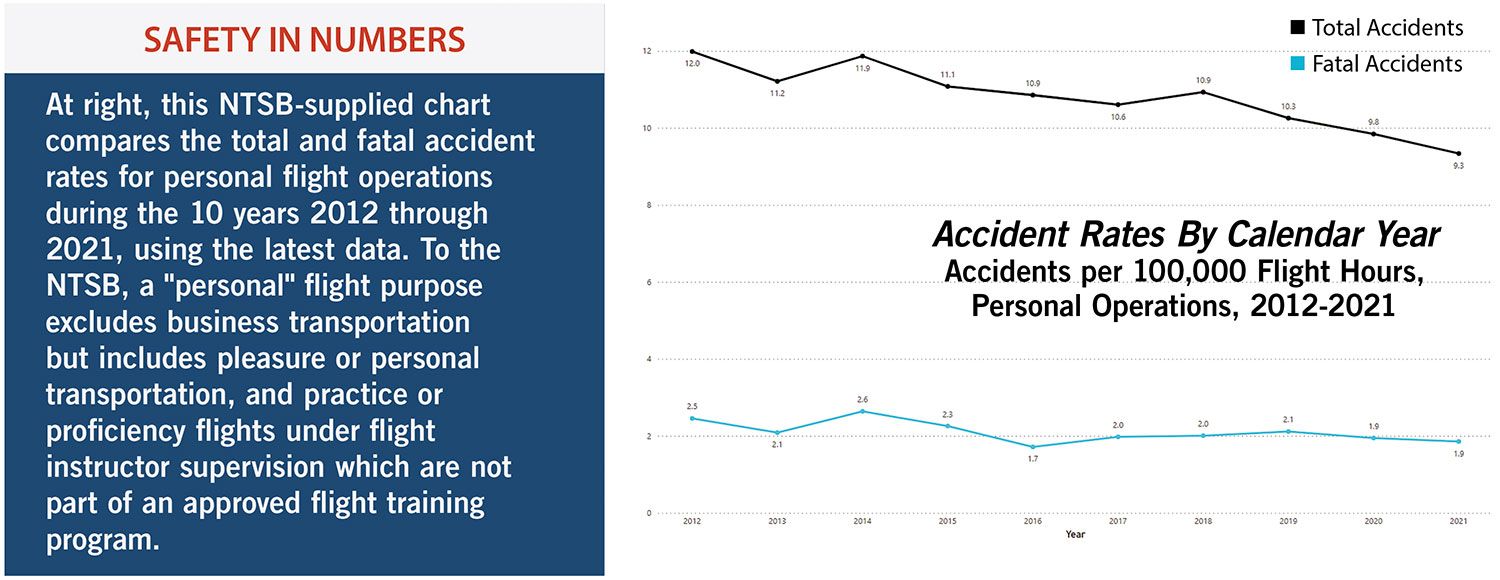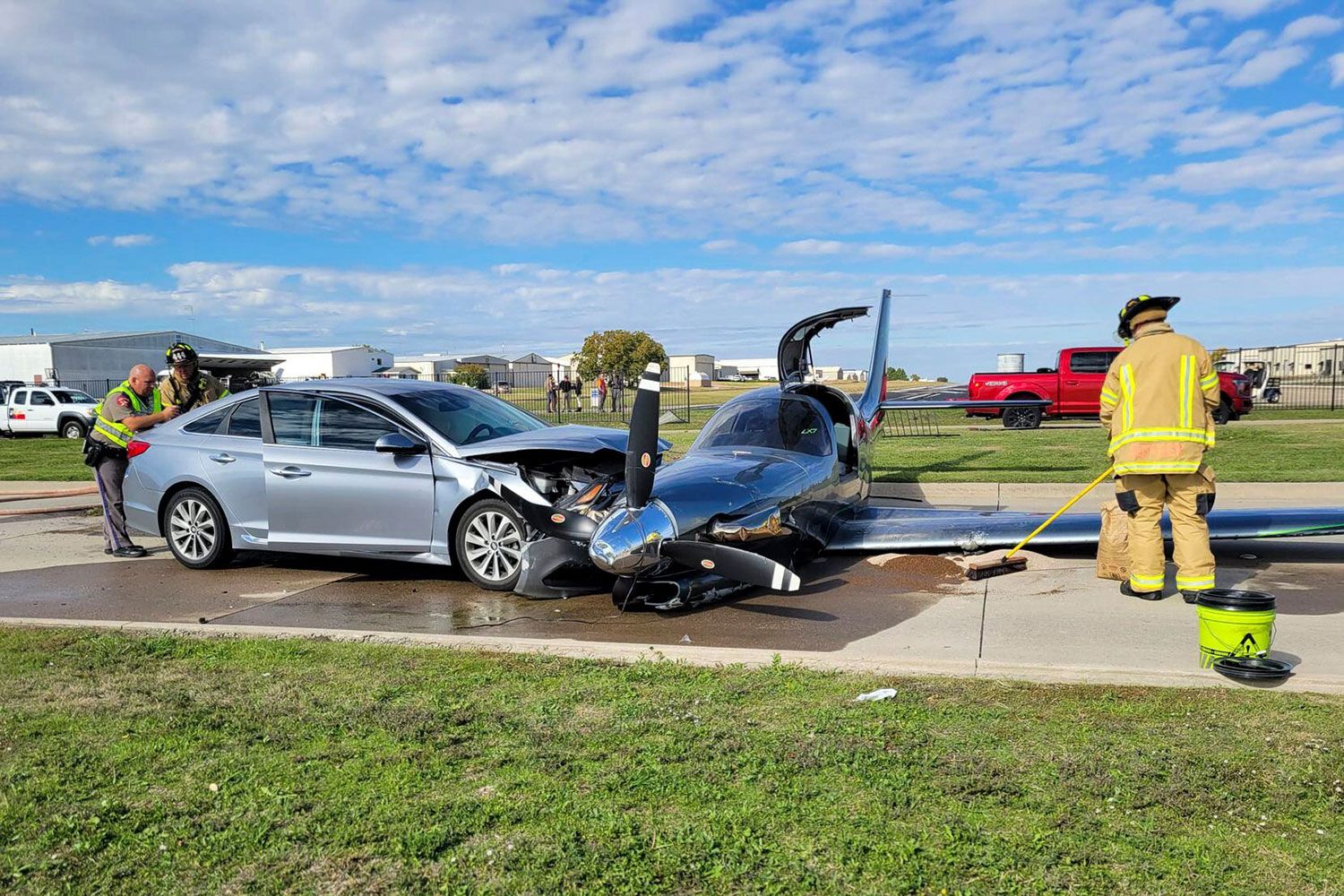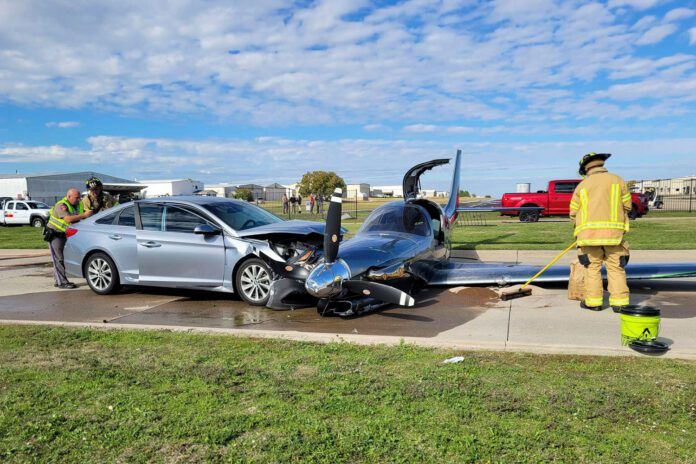 November 7, 2023, Jackson, Mich.
November 7, 2023, Jackson, Mich.
Aero Commander 500B
At 1510 Eastern time, the airplane was substantially damaged when both of its engines lost power in cruise flight and the pilot force-landed it off-airport. The solo pilot was uninjured. The airplane was being operated as a FAR Part 135 on-demand cargo flight.
While en route, both engines lost power. The pilot then performed the off-airport landing, during which the airplane sustained substantial damage to its fuselage. A post-accident run of both engines revealed no mechanical anomalies precluding normal operation. Examination revealed the fuel quantity indicator was inoperative.
November 7, 2023, London, Ky.
Van’s RV-4 Experimental
The pilot bought the airplane the day before the accident. While landing, the airplane bounced and the pilot intended to abort the landing. Instead, he accidentally advanced the elevator trim lever, rather than the throttle lever, which were similar in position and shape. The airplane touched down in a nose-low attitude, resulting in damage to the main landing gear, propeller and fuselage components. The NTSB’s probable cause statement: “The pilot’s inadvertent application of nose down pitch trim during the attempted aborted landing, which resulted in abnormal contact with the runway.”
November 8, 2023, Fort Worth, Texas
Grumman American AA-5 Traveler
While taxiing on a dry asphalt taxiway, the pilot observed a motorcycle coming toward the airplane. As he focused on the motorcycle, the right wing impacted several garbage cans, causing the airplane to turn right. It then impacted a hangar door. The pilot was uninjured; the airplane’s right wing sustained substantial damage. This was the pilot’s first visit to the airport, and he reported he did not visually observe the garbage cans, which were in shadow. According to the NTSB, the FAA’s Chart Supplement entry for the airport states, “uncontrolled vehicle tfc inv of hangars and on twys.”
The NTSB has already issued a probable cause statement: “The distraction of the pilot during the taxi, resulting in a ground collision.”
November 9, 2023, Erie, Colo.
Cessna 172S Skyhawk SP
The airplane was substantially damaged at about 0930 Mountain time when its crew performed a precautionary landing after the engine partially lost power. The flight instructor and the student pilot were not injured.
Upon engine start, the pair noticed the engine was shaking and that the alternator was not charging the battery. They shut down and inspected the engine and alternator belt. Everything appeared normal, so they restarted the engine. Everything “was in the green” and all systems appeared normal, and the two took off at about 0840. After a simulated emergency descent and landing, the student pilot applied full power to recover, but the engine started to shake and its rpm dropped. The flight instructor set up to land at the departure airport but the airplane was too high and fast. The flight instructor instead maneuvered the airplane to touch down in a field, which was uneventful until the airplane rolled nose-first into a culvert, resulting in substantial damage.
Examination revealed the #4 cylinder had no compression, its exhaust valve was stuck open and its push rod was bent.
November 11, 2023, McKinney, Texas
RRD/Lancair LX7 Experimental
At about 1241 Central time, the airplane sustained substantial damage when it overran the landing runway, and then rolled through a perimeter fence and into a moving vehicle. The pilot and passenger were not injured; an automobile occupant sustained minor injuries.
While en route at FL250, a door seal failed, causing loss of cabin pressurization. The pilot conducted an emergency descent to 10,000 feet msl and continued the flight. The pilot noted no aircraft systems anomalies except an amber caution light for propeller speed of 1920 rpm. The pilot reduced rpm, extinguishing the caution light. After a touch-and-go landing, the pilot flew a normal traffic pattern to Runway 17. On the downwind, as he reduced power, the lever’s ball came off in his hand. The pilot handed the ball to the passenger and continued the landing at the flight idle power position.
A video showed the airplane touch down and bounce near the halfway point of the 3002-foot-long asphalt runway. All three landing gear were on the runway surface and smoke from main landing gear wheels/tires appeared about three seconds later. “The wheel/tire smoke continued until the airplane exited the runway surface,” according to the NTSB. Skid marks were visible for about 1300 feet, until the airplane departed the asphalt surface. The airplane continued 14 feet to the perimeter fence and then another 93 feet before contacting a moving automobile in a roadway.

November 11, 2023, Columbia, Tenn.
Taylorcraft BC-12-65
The airplane was substantially damaged at about 0815 Eastern time when its engine lost power during initial climb. The solo private pilot had minor injuries.
The pilot reported confirming there were about 12 gallons of fuel aboard. Including engine start, taxi and pre-takeoff runup operations, the engine was running for about 25 minutes with no anomalies noted. He applied power for takeoff and the engine accelerated “strongly and smoothly” At about 25-30 feet agl, the engine suddenly lost about 1000 rpm. The pilot performed an off-field landing, touching down in an area of high grass, damaging the airplane’s wings and forward fuselage.
November 12, 2023, Anchorage, Alaska
Piper PA-22 Tri-Pacer
At about 1615 Alaska time, the airplane sustained substantial damage when it was force-landed short of the intended runway after its engine lost all power. The solo pilot was not injured.
While waiting for the weather to improve, he spent about 15 minutes running the engine and taxiing before tower personnel allowed him to fly a traffic pattern. At about 1610, he departed Runway 32 and entered a closed right-hand traffic pattern. During the base-to-final turn, there was no response from the engine. The engine then lost all power. Remedial actions were unsuccessful and he landed short of the runway, damaging the fuselage and left wing strut.
November 13, 2023, Hayden, Idaho
Cessna 310D
The airplane was substantially damaged at about 0800 Pacific time in an apparent VMC rollover short of the intended runway. The solo pilot sustained minor injuries.
Shortly after takeoff, while climbing to 4500 feet msl, the pilot noticed that the left engine’s manifold pressure was lower than the right engine’s. Troubleshooting failed to resolve the issue. He also noted the left engine seemed to be unresponsive. The pilot decided to return to the departure airport.
While on final approach to Runway 2, the left engine “either went to idle or lost all power,” followed by the sound of the stall warning horn. The airplane then immediately rolled left and impacted the ground about 250 feet short of the runway.
November 14, 2023, Lowell, Ind.
Bede BD-4 Experimental
At about 1353 Central time, the airplane was substantially damaged when it was force-landed in a soybean field. The pilot sustained minor injuries.
The pilot later reported the engine began to run roughly and shake violently while en route. Upon touching down in the field, the airplane flipped over, damaging the wings, fuselage and vertical stabilizer. After exiting the airplane, the pilot noticed that one of the propeller blades was missing.
November 17, 2023, Ozark, Mo.
Piper PA-32-300 Cherokee Six
The airplane was substantially damaged at about 1524 Central time during an off-airport landing following engine failure. The pilot received minor injuries.
The pilot refueled the airplane before departing Quincy, Ill. While en route to his destination, the engine lost all power. The pilot switched fuel tanks and attempted to restart the engine. Unable to restore engine power, the pilot performed a forced landing to a field. During the approach, the airplane collided with a power line and impacted terrain, coming to rest inverted.
November 14, 2023, Micanopy, Fla.
Piper PA-28-180 Cherokee 180
At 1409 Eastern time, the airplane was destroyed when its 66-hour pilot apparently lost control and collided with terrain. The non-instrument-rated private pilot was fatally injured.
After departing the Kissimmee (Fla.) Gateway Airport (KISM) at about 1245, the airplane flew a northerly track until about 1333, when a brief turn to the east was observed, followed by a left turn back to a northerly heading. The airplane then performed several erratic 360-degree turns, climbing as high as 6900 feet msl and descending as low as 500 feet msl between 1335 and 1409, prior to losing radar contact. The final ADS-B data point’s rate of descent was in excess of 5000 fpm.
A review of ATC communications revealed that during his maneuvering, the pilot called “mayday” and stated he “was lost in weather.” The pilot reported multiple times that he was having issues with his instruments, “mistakenly flew into weather,” “it’s completely white” and he could not see anything outside. The airplane came to rest in a heavily wooded area at an elevation of 100 feet msl. All major components were located in the vicinity of the main wreckage.
November 17, 2023, Perry, Fla.
Lancair IV Experimental
At about 1708 Eastern time, the airplane was substantially damaged during an off-airport landing with an unresponsive engine. The pilot sustained minor injuries.
The pilot was in cruise flight at 11,500 feet msl “with about 40 minutes of daylight remaining” when he noted an undercast and decided to descend through a hole and divert to Perry, Florida. On leveling off underneath the cloud layer at 2000 feet, he tried to add power but “nothing happened.” He pulled the throttle fully out, expecting the engine to slow, but engine power remained unchanged. Remedial actions failed to restore engine power, so he elected to execute a forced landing into sapling pine trees. The wings and fuselage were substantially damaged.
November 18, 2023, Woodland, Wash.
Cessna 150M
The airplane was substantially damaged at about 1522 Pacific time when its engine failed to respond to throttle input and it was landed off-airport. The flight instructor and student pilot were uninjured.
At about 3500 feet msl, the instructor demonstrated a stall. As they recovered by releasing back pressure on the yoke and applying full throttle, the airplane’s power setting remained at idle. Despite remedial measures, engine power remained unchanged and the instructor decided to execute an emergency landing. Shortly after touchdown in a nearby field, the nose landing gear separated and the airplane nosed over.
November 18, 2023, Barataria, La.
Cessna A185F Skywagon
The pilot reported setting up the float-equipped airplane for landing on an intracoastal waterway and picking a landing area based on the locations of three nearby boats. During final approach, she had the three boats in sight, one of which was on the far right side of the waterway and traveling in the same direction, and determined they would not be a factor.
The airplane touched down on the choppy water, and she added power to keep the floats on the step. Immediately after touchdown, the airplane veered left and then nosed over, substantially damaging the right wing. After egressing the airplane without further incident, the pilot noticed the recreational boat that was originally on the right side of the waterway was now on the left side, and the boat driver stated that the airplane hit the boat.
The NTSB determined the probable cause of this accident to be: “A recreational boat crossed in front of the airplane’s path during landing on the water which resulted in the airplane colliding with the boat.”




